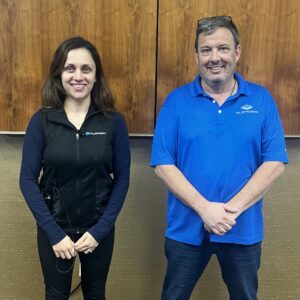|
|
 Madhura Maskasky and Peter Fray presented for Platform9 at Cloud Field Day 19 |
This Presentation date is January 31, 2024 at 13:00-14:30.
Presenters: Madhura Maskasky, Peter Fray
Platform9 is excited to showcase, at Cloud Field Day, our ground-breaking innovative product called Elastic Machine Pool (EMP) (https://elasticmachinepool.com). Our latest innovation doubles EKS efficiency and saves 50% or more on AWS costs. Designed for DevOps/FinOps teams, EMP dramatically improves your EKS cluster CPU and memory utilization – with zero app/pod disruptions and no changes required to your app resource configuration set by the developers. Check out the announcement blog by our CTO: https://platform9.com/blog/platform9s-elastic-machine-pool-the-most-cost-effective-compute-engine-for-eks/
Democratizing Cloud Computing with Platform9
Watch on YouTube
Watch on Vimeo
Madhura Maskasky, Co-Founder and VP of Product at Platform9 Systems, introduces Platform9, the main offerings of the company, and a discussion about the “cloud engine” which forms the unique IP that wraps around open-source software to simplify operations with “Always-On Assurance”. The session will further outline the proactive operations methodology, which includes Comprehensive Monitoring, Proactive Issue Identification, Automated Alerting and Ticket Generation, Enhanced System Reliability. The session will end with a review of how a full stack is deployed across 1000s of location in an automated and repeatable way.
The session covers an overview of Platform9, its mission to democratize cloud computing, and the unique services it offers to enterprises. Platform9’s approach involves using open-source software like Kubernetes, OpenStack, and other components, which are then packaged and deployed through a SaaS model. This is coupled with their “Always-On Assurance” guarantee, which ensures high operational efficiency and reliability for cloud infrastructures at scale.
The proactive operations methodology includes comprehensive monitoring, proactive issue identification, automated alerting, and ticket generation. This methodology is powered by a “hidden product” that operates 24/7, monitoring infrastructure, collecting metrics, and analyzing data to maintain a 99.9% SLA for enterprise customers.
During the session, Madhura explains how Platform9 manages customers’ infrastructure remotely, configuring hardware, installing operating systems, deploying Kubernetes or OpenStack, and providing a layer of PaaS services for applications. The discussion also touches on technical aspects such as the use of Prometheus for metrics, Loki and ELK for log aggregation, and Vault for secret management.
Questions from the audience address the intervals at which data is collected, the use of other tools like Splunk and Dynatrace, and the role of Platform9’s support team in application-level monitoring. It is clarified that while Platform9 is responsible for platform-level SLAs, customers can still use their own tools for application-level monitoring and can request access to Platform9’s collected data if needed.
The session concludes with Madhura mentioning some of Platform9’s customers, such as Juniper Networks, Rackspace, Cloudera, and SambaNova, and noting that they manage over 15,000 active nodes worldwide. An attendee inquires about HPE’s use of Platform9, and Madhura confirms that an HPE team uses their OpenStack product for DevTest private cloud purposes.
Personnel: Madhura Maskasky
Introduction to Platform9 Elastic Machine Pool
Watch on YouTube
Watch on Vimeo
In this presentation, Madhura Maskasky, the Co-Founder and VP of Product at Platform9 Systems, introduces their new product called Elastic Machine Pool (EMP). EMP aims to optimize compute utilization and reduce costs for Kubernetes in public clouds by at least 50%. EMP is unique in the market because it addresses the inefficiency of Kubernetes, which often uses only around 30% of its allocated resources.
EMP works by provisioning bare metal nodes and deploying optimized virtual machines on top of them, called elastic virtual machines (EVMs). A rebalancer component ensures even distribution of resources across the pool of bare metal nodes and can live-migrate VMs without disrupting applications. This allows for over-provisioning and better bin packing without compromising application SLAs.
The product targets DevOps, FinOps, and PlatformOps users and fits into the FinOps landscape by potentially reducing EKS costs significantly. EMP is complementary to other tools that provide cost visibility but differentiates itself by improving utilization and eliminating the need to constantly adjust app configurations for cost optimization.
EMP is licensed on a risk-reward model, charging a percentage of the actual savings it generates for customers. The discussion also covers the importance of feedback loops for engineers to understand resource usage better and the potential expansion of EMP to other clouds beyond AWS.
The presentation concludes with an emphasis on the significant potential cost savings that EMP can offer and its ability to operate seamlessly within existing Kubernetes clusters without requiring fundamental changes or app disruptions.
Personnel: Madhura Maskasky
Platform9 EMP Cost Analyzer and EKS Cluster Management Demo
Watch on YouTube
Watch on Vimeo
Platform9 Systems demonstrates Elastic Machine Pool (EMP) Cost Analyzer and their approach to managing Amazon EKS clusters. Peter Fray, Field CTO, and Madhura Maskasky, VP of Product, showcase how their tool can calculate potential savings for AWS EKS clusters by analyzing current costs and projecting savings and explain how EMP serves as an alternative to AWS Fargate by managing worker nodes and potentially reducing costs.
The demo includes the following:
1. An overview of the existing AWS environment with EC2 worker nodes.
2. A live demo of the EMP Cost Analyzer, projecting significant cost savings by running multiple EC2 instances on a single bare metal node.
3. A discussion on how EMP compares to AWS serverless offerings like Lambda and Fargate, emphasizing cost savings and management benefits.
4. An explanation of how to install the cost analyzer using a Helm chart and how it integrates with AWS.
5. A demonstration of how to create and manage EVM pools, configure overcommitment, and scale bare metal nodes according to workload demand.
6. An outline of the process for migrating from a traditional EKS cluster to one managed by EMP.
7. A discussion on the future expansion of EMP beyond AWS EKS to other Kubernetes offerings and possibly EC2.
8. A Q&A session addressing technical details, automation capabilities, and go-to-market strategies, including the AWS marketplace presence.
The demo illustrates the potential for significant cost savings and simplified cluster management for AWS EKS users through the use of Platform9’s EMP.
Personnel: Madhura Maskasky, Peter Fray








